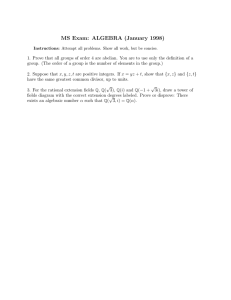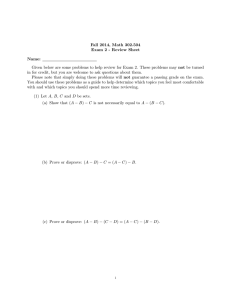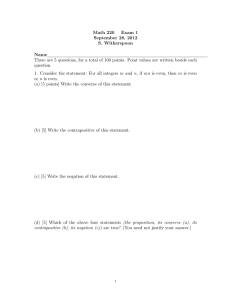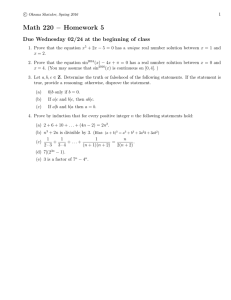COT 3100 Homework #4 Summer 2008 Assigned: 6/23/08 Due: 7/2/08 (in class)
advertisement
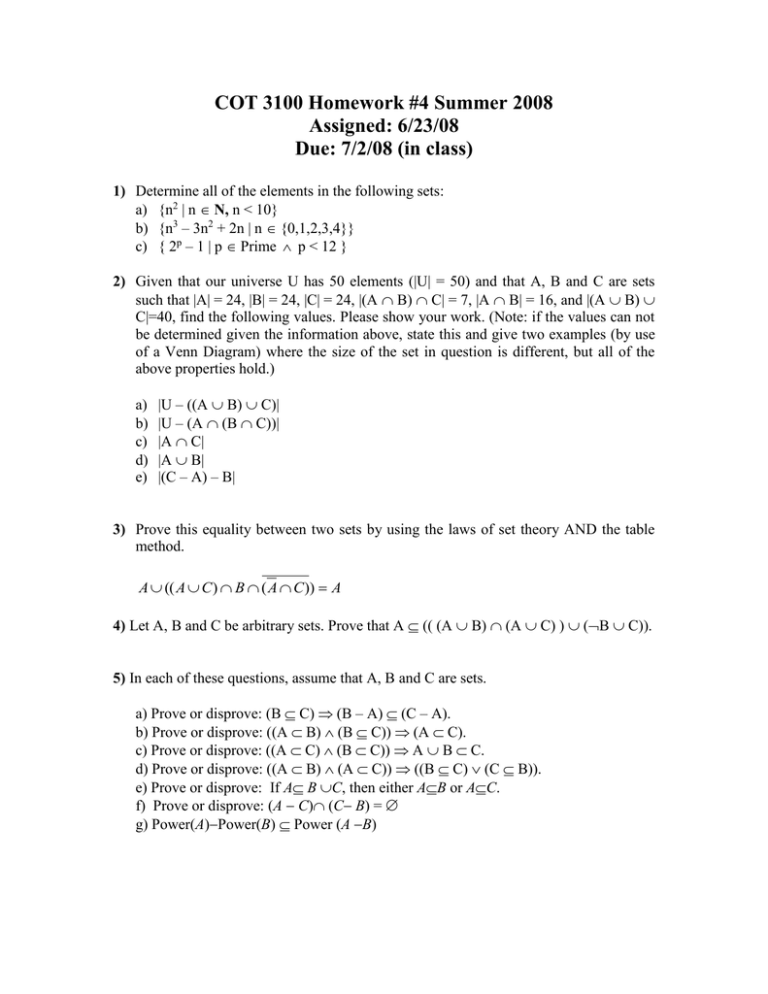
COT 3100 Homework #4 Summer 2008
Assigned: 6/23/08
Due: 7/2/08 (in class)
1) Determine all of the elements in the following sets:
a) {n2 | n N, n < 10}
b) {n3 – 3n2 + 2n | n {0,1,2,3,4}}
c) { 2p – 1 | p Prime p < 12 }
2) Given that our universe U has 50 elements (|U| = 50) and that A, B and C are sets
such that |A| = 24, |B| = 24, |C| = 24, |(A B) C| = 7, |A B| = 16, and |(A B)
C|=40, find the following values. Please show your work. (Note: if the values can not
be determined given the information above, state this and give two examples (by use
of a Venn Diagram) where the size of the set in question is different, but all of the
above properties hold.)
a)
b)
c)
d)
e)
|U – ((A B) C)|
|U – (A (B C))|
|A C|
|A B|
|(C – A) – B|
3) Prove this equality between two sets by using the laws of set theory AND the table
method.
A (( A C ) B ( A C )) A
4) Let A, B and C be arbitrary sets. Prove that A (( (A B) (A C) ) (B C)).
5) In each of these questions, assume that A, B and C are sets.
a) Prove or disprove: (B C) (B – A) (C – A).
b) Prove or disprove: ((A B) (B C)) (A C).
c) Prove or disprove: ((A C) (B C)) A B C.
d) Prove or disprove: ((A B) (A C)) ((B C) (C B)).
e) Prove or disprove: If A B C, then either AB or AC.
f) Prove or disprove: (A C) (C B) =
g) Power(A)Power(B) Power (A B)
Programming Alternative
If you do this program, you can skip the following written questions:
2, 4, 5a, 5d, 5e, 5f.
Thus, if you do this question, you SHOULD also answer: 1, 3, 5b, 5c and 5g.
Write a program that will help someone learn the basic operations of sets.
Your program will first prompt the user to enter in all the values (positive integers) in set
A, followed by -1. (Note: A could be empty, and that the integers may not be entered in
numerical order.)
Then your program will prompt the user to enter in all the values (positive integers in set
B, followed by -1. (Note: B could be empty, and that the integers may not be entered in
numerical order.)
Note: The user is guaranteed to enter a maximum of 20 positive values for set A, and a
maximum of 20 positive values for set B.
Your program should then print out the following sets:
A B
A B
A B
AxB
A sample run is provided below. It is not necessary for your output to match exactly
(especially format issues such as commas, etc.), but make sure you at least print out the
proper elements of each set. If possible, do try to print out the elements in each set in
sorted order. But if you don't do this, there will only be a small deduction.
Sample Run
Please enter the elements in set A followed by -1.
3 8 2 9 1 -1
Please enter the elements in set B followed by -1.
2 7 -1
A union B = {1, 2, 3, 7, 8, 9}
A intersect B = {2}
A minus B = {1, 3, 8, 9}
A cross B = {(1,2), (1,7), (2,2), (2,7), (3,2), (3,7),
(8,2), (8,7), (9,2), (9,7)}
